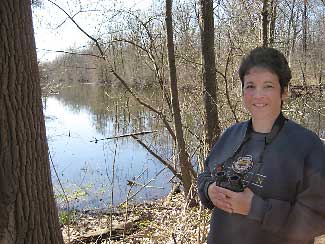Julie Craves knows a thing or two about birds, including when it’s appropriate to “pish.”

Pishing is an acoustic method used to lure birds out of hiding, says Craves, supervisor of avian research at U-M-Dearborn’s Rouge River Bird Observatory. Craves extensively has studied Michigan birds since 1992.
There’s a time and place to pish, she explains. “Pish around nonbirders, who have no idea what you are doing, and the response may be the same as if you had made some other type of bodily noise,” she writes.
Basically, pishing involves clenching the front teeth and quickly saying the word “pish,” quietly but urgently. A birder also might say “seet” in a hissing manner while keeping the teeth clenched. The idea is to get a bird to investigate the sound, luring it into view.
In her job, Craves has studied state birds through an annual banding program. It evaluates the importance of urban natural areas as stopover sites for migratory birds. She and her colleagues study why birds stop at one site and not others, how long they stay in one area and what habitat features help the birds migrate successfully.
An understanding of how birds use urban areas during migration and how to manage these areas is critical for their continued survival, Craves explains. She also has worked in Cuba to develop bird survey routes and protocols that can be used by future environmental tourists and educational groups to assess the health of the country’s bird populations.
Craves’ academic reputation in the avian field earned her an invitation to write about pishing. Her essay “A Little Pish Will Do Ya,” appears in the new book “Good Birders Don’t Wear White: 50 Tips From North America’s Top Birders,” published this month by Houghton Mifflin.
“I was given complete leeway on subject matter, within the guidelines of light and fun birding advice,” Craves says.
Purchases of “Good Birders Don’t Wear White” through the Rouge River Bird Observatory Web site help to support the work of the observatory, which is funded solely by donations from corporations, foundations and individuals.
Craves, a contributing editor of Birder’s World magazine since 1999, is the author of “The Birds of Southeast Michigan: Dearborn,” which is being revised to include 10 years of new material covering 263 species, along with guides and maps to birding locations and trails in Dearborn.
For more information, visit the observatory’s Web store at www.umd.umich.edu/dept/rouge_river/store.html.

